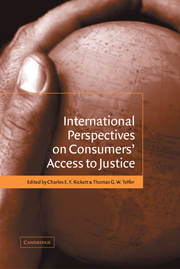Book contents
- Frontmatter
- Contents
- List of contributors
- Preface
- Table of cases
- Table of statutes
- 1 Consumers' access to justice: an introduction
- Part I Perspectives on consumers' access to justice
- Part II Issues in contract and tort
- Part III Services and the consumer
- Part IV Consumer bankruptcy law
- Part V Procedure and process issues
- Part VI Conflict of laws issues
- Index
1 - Consumers' access to justice: an introduction
Published online by Cambridge University Press: 11 July 2009
- Frontmatter
- Contents
- List of contributors
- Preface
- Table of cases
- Table of statutes
- 1 Consumers' access to justice: an introduction
- Part I Perspectives on consumers' access to justice
- Part II Issues in contract and tort
- Part III Services and the consumer
- Part IV Consumer bankruptcy law
- Part V Procedure and process issues
- Part VI Conflict of laws issues
- Index
Summary
Introduction
Consumer protection law in the age of globalisation poses new challenges for policy-makers. The legislative and regulatory framework developed to undergird consumer protection law in the 1960s and 1970s has come under pressure, ‘spurred’, as Michael Trebilcock suggests in his essay in this volume, ‘both by the changes in the nature of modern industrial economies and the evolution of economic theories’. Trebilcock argues that consumer protection law at the beginning of the new millennium ‘is a much messier and more complex affair’ than it was some thirty or forty years ago. The changes he describes include ‘rapidity of technological change, deregulation of hitherto monopolised industries, globalisation of markets’ and the ‘increasing sophistication in economic theories that evaluate market structure, conduct and performance’.
Governments can no longer develop domestic consumer protection law in isolation from international developments. Iain Ramsay argues herein that globalisation has ‘increased the international dimensions of access to justice and consumer protection as developments in communication technology facilitate the possibility of cross-border frauds’. Consumer law in the twenty-first century must become what he calls ‘applied comparative law’.
The growth of international consumer transactions and the emergence of a new conception of the role of the state have led to a proliferation of consumer protection models all designed with the idea of improving access to justice. As Ramsay demonstrates in his essay, consumer protection and access to justice have traditionally been linked.
- Type
- Chapter
- Information
- Publisher: Cambridge University PressPrint publication year: 2003



